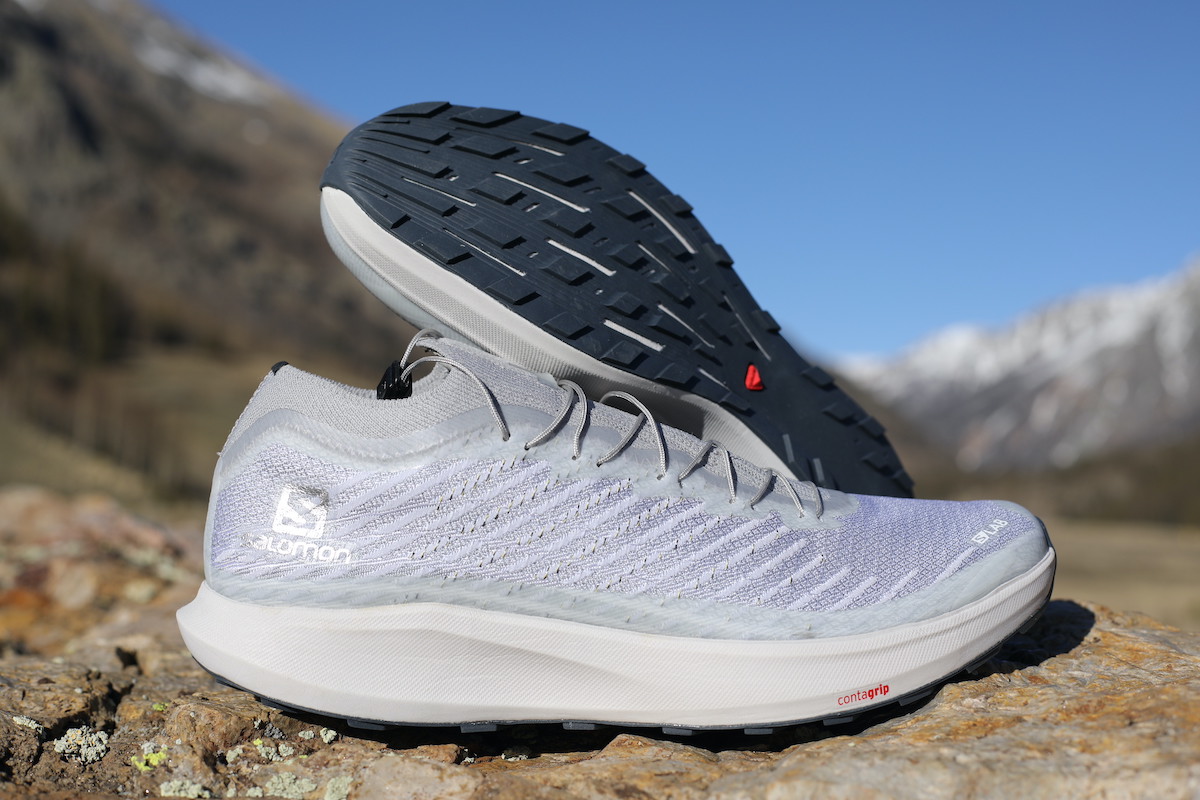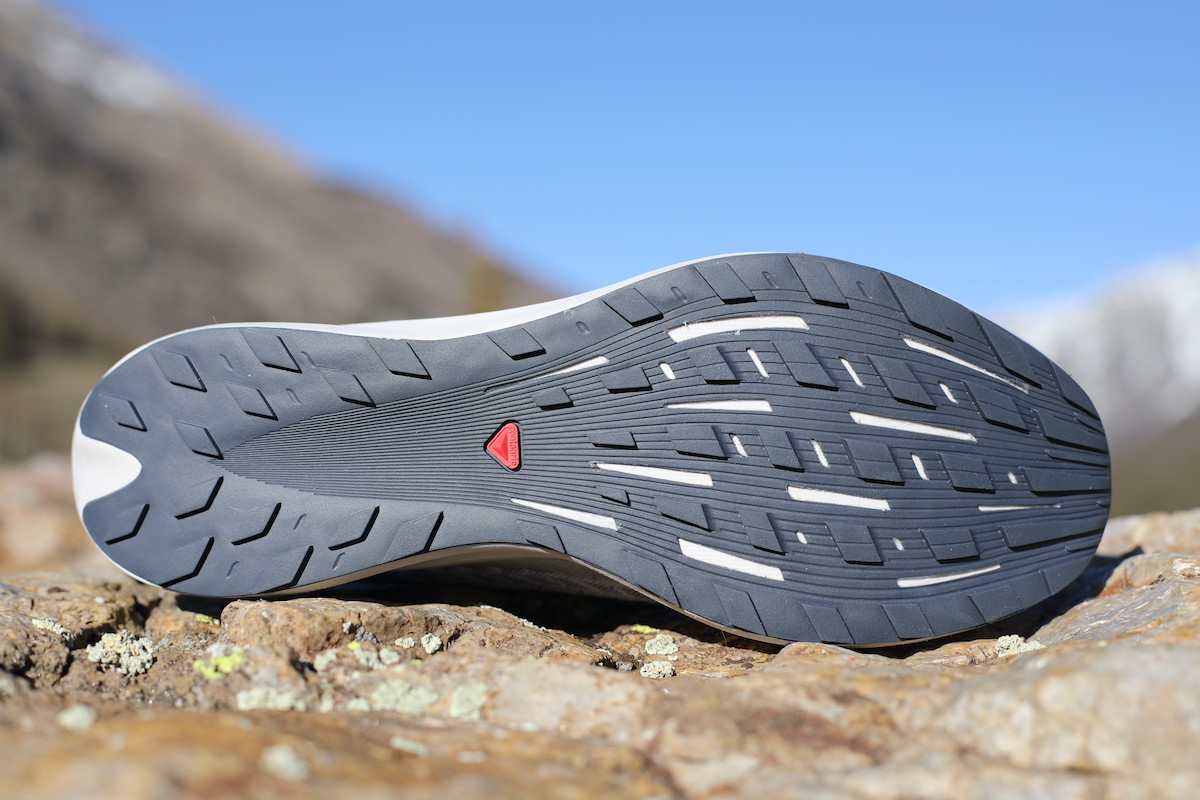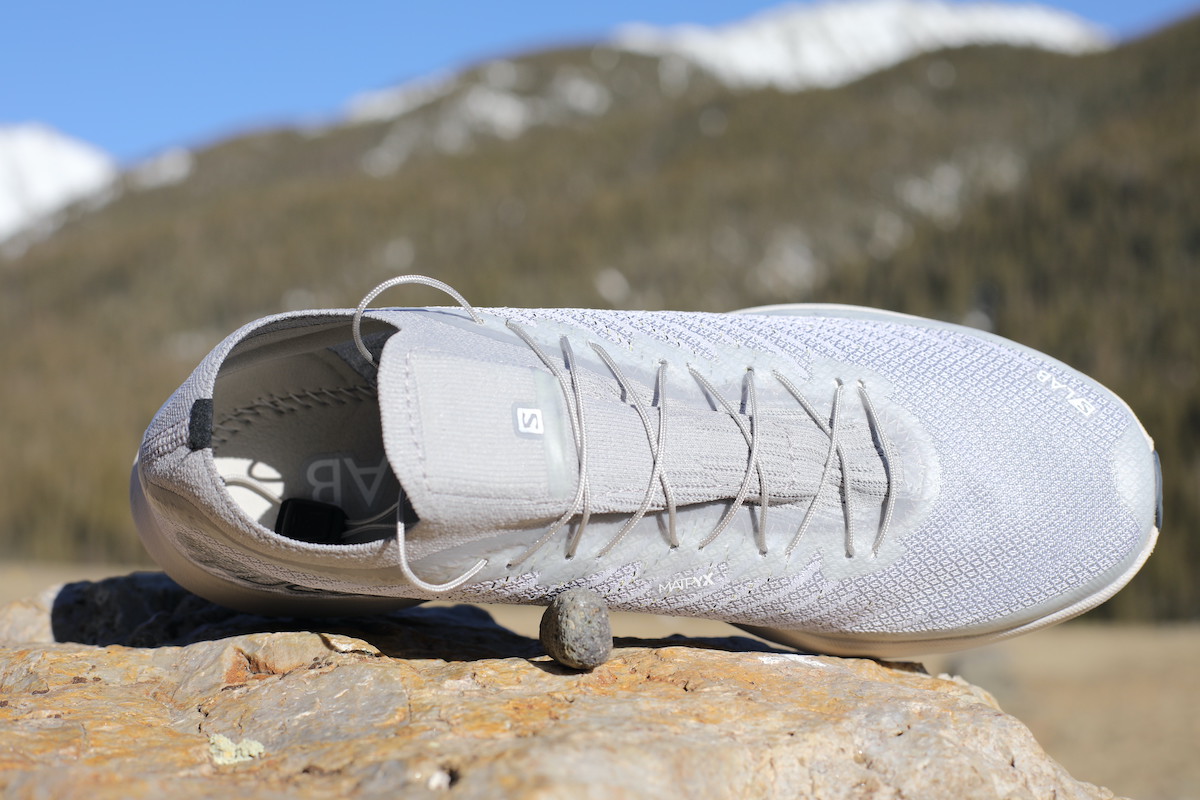For the latest on the S/Lab Pulsar family, read our full Salomon S/Lab Pulsar 3 review.
Our Favorite Trail Running Shoes
Check out our Best Trail Running Shoes buyer’s guide to learn about our current favorite trail running shoes!
Salomon S/Lab Pulsar Review
As professional hiker Andrew Skurka says, “There’s light, and then there’s stupid light.” The Salomon S/Lab Pulsar ($180) is just a couple grams away from stupid light. At a weight of 6.2 ounces (175 grams) in a men’s size 9, the shoe floats in your hands when you take it out of the box, and except for the snugness of fit, is virtually unnoticeable while wearing.
It was recently revealed that after 15 years, Kilian Jornet is not reupping his sponsorship with Salomon in 2022. It’s no wonder that with his impending departure, his crowning achievement comes by way of the Pulsar, a shoe so confusingly perfect that it could only come from the mind of a genius, along with the incredible Salomon design team.
The Pulsar has very few flaws, and one of my complaints might simply be related to my local trail conditions — more on that below. Otherwise, what you find in this package is a lightweight trail racing shoe that you can quite possibly use for your faster day-to-day training as well.
Overall, we named the Salomon S/Lab Pulsar as the best short distance trail racing shoe in our best trail racing shoes buyer’s guide. For our best generalist trail shoe picks, check our trail running shoes buyer’s guide.
Shop the Salomon S/Lab PulsarSalomon S/Lab Pulsar Upper
When I first tried on these shoes, I emailed iRunFar Editor-in-Chief Bryon Powell in a fit of frustration to ask about his experience with the incredibly snug fit of the Salomon S/Lab Pulsar. I complained that although the shoe feels perfect while running, getting my feet into the things was another matter.
He suggested a shoehorn, and I concur. The worst quality of this shoe is how hard it is to get onto your foot, and mechanical assistance might be necessary. However, once on, the upper is so sock-like that you practically forget you’re wearing anything at all. It is perfect.
The mesh conforms to your foot, allowing it to splay out like in foot-shaped shoes like Altra or Topo. Even if you tend to avoid Salomon shoes because of their historically narrow fit, you should find the Pulsar accommodating. Not only are my feet wider than average, but I also have bunions, yet still I found the material relaxed enough for my feet.
Though Salomon touts the breathability of the upper’s Matryx mesh, I found the Pulsar to be so sock-like that it doesn’t let air through. I regularly wear these both with and without running socks. There is no removable insole.
The Matryx mesh is reinforced with super-strong aramid fibers, a material commonly used in aerospace and military applications. In over 200 miles, there is no wear on the sidewalls of these shoes. The material is proving to be very robust.
The Salomon S/Lab Pulsar uses Salomon’s traditional Quicklace system, but often I’d just leave the laces loose; the upper is so snug that you’re already locked in even without the lacing. A tongue garage allows you to stow the lace tab adjuster, the same design as on the Salomon S/Lab Ultra 3. Check out our Salomon S/Lab Ultra 3 review to learn more about that shoe.
The shoes are a white-ish gray color — called “Vapor Blue” by the brand — and they take on the color of your trails. After my first run in the shoes, my pair took on a patina of brown and tan that only sort of goes away after a washing machine cycle.
Salomon S/Lab Pulsar Midsole
The Salomon S/Lab Pulsar has Salomon’s lightest ever midsole and gives a propulsive ride, the rocker shape almost forcing you onto your toes even at a standstill. Six millimeters of heel-to-toe drop accompany the Energy Surge EVA that feels plush, something you can’t say about a lot of other Salomon running shoes. For a shoe that begs to be put to the test on uphill ascent PRs, the foam is so supportive that the Pulsar can easily cover longer distances.
I wore the Pulsars for nearly all of my short uphill workouts last fall, but also for the Boulder Skyline Traverse, an 18-mile run up, down, and across the five prominent peaks above Boulder, Colorado, where I live. I suffered none of the residual effects you’d find in comparable lightweight shoes over that distance, like sore calves or quadriceps. I confidently use the Pulsar on runs of up to 30 miles.
The Pulsar is fairly accommodating when it comes to different foot strikes, particularly for a racing shoe. You can actually let your guard down with forefoot striking and settle into the midfoot, which is so surprising given the ratio of cushioning to weight. I haven’t tested another shoe with such a stark dynamic. Saying the shoe has a plush ride might be an overstatement, but it’s damn near close.
The Pulsar uses Salomon’s very new material invention: Energy Surge. This is a midsole material they developed with Dow, the material science company. The material is called Infuse by Dow but trademarked as Energy Surge by Salomon. The company says there is less EVA and it removes the Optivibe vibration reduction in many of Salomon’s current or former models. Save for S/Lab models, my experience with Salomon’s midsoles have been very firm, so much so that I relegated them to hiking shoes or just stopped buying them entirely. Salomon says the firmness of the Energy Surge is 10 points less than Optivibe on the durometer scale and the compression setting, known as rebound, is improved. These two areas were the standouts from my experience testing the Pulsar, helping both my turnover and comfort, and the midsole has remained springy and responsive over time.
Salomon S/Lab Pulsar Outsole
Here we find my one complaint in the otherwise incredible Salomon S/Lab Pulsar.
The trails I run 99% of the time are soft but somewhat slick. Our dry climate creates a thin layer of loose dirt at the surface, lying over hardpacked soil. While running in the Pulsar, this meant learning to brake check, particularly around switchback turns. I took at least two, cartoon-like, banana-peel falls when rounding turns too quickly. One resulted in a nasty gash on my hip, similar to when you crash a road bike on pavement. I suspect traction is much improved on slightly damper or loamy surfaces. The lugs are only 2.5 millimeters deep, and are made of Salomon’s Contagrip compound.
Incidentally, the word “grip” is not mentioned a single time on Salomon’s product page for the shoe, like you are implicitly sacrificing a bit of control when opting for the Pulsar. Though this is essentially a racing flat for trail running, underfoot protection is very good, and I suffered virtually no pain from landing wrong on sharp rocks.
Salomon S/Lab Pulsar Overall Impressions
Through Kilian Jornet, who helped to design this shoe has left the proverbial building, if this shoe suggests the future of Salomon, then the brand has created an incredible option for racing and fast daily training in the Salomon S/Lab Pulsar.
Though I find the Pulsars quite hard to get on my feet, sort of like a ski boot or climbing shoe, when I finally get them on, they are incredibly secure and the fit is perfect. Adding a pull tab for the heel collar would be really appreciated — but again, weight savings!
Shop the Salomon S/Lab PulsarCall for Comments
- Have you tried out the quick and nimble Salomon S/Lab Pulsar? Let us know about your experiences.
- What other shoes of the past or present would you compare with the Pulsar?
[Editor’s Note: If you’re affiliated (i.e., an employee, ambassador, etc.) with a brand, please share your relation in each of your comments on this article. Thanks!]
A top view of the Salomon S/Lab Pulsar.





